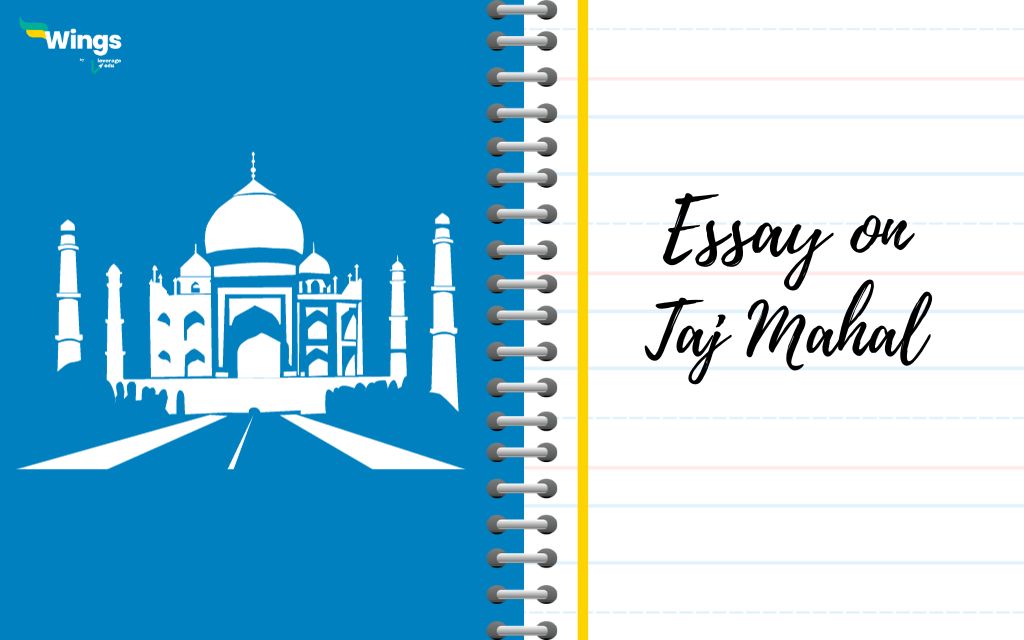Essay on Taj Mahal: The Taj Mahal is one of the most iconic and celebrated monuments in the world and is listed among the wonders of the world. This ivory-white marble mausoleum is located on the bank of Yamuna in Agra, India. Its design, significance, and history make it a sign of love and a masterpiece of human craftsmanship. It is also known as the 7th wonder of the world. This blog determines the historical significance and also drafted a sample essay on Taj Mahal in 100, 250, and 500 words to help the school students.
Contents
Historical Significance of the Taj Mahal
Commissioned in 1632 by the Mughal Emperor Shah Jahan, the Taj Mahal was built in memory of his beloved wife Mumtaz Mahal, who died during childbirth. This monument is also referred to as the symbol of love. It demonstrates the excellence of Mughal architecture.
The Taj Mahal is an architectural marvel that seamlessly blends various design influences, such as Persian, Islamic, and Indian styles. In 1983, the Taj Mahal was designated as a UNESCO World Heritage Site, further cementing its importance on a global scale. The Taj Mahal is more than just a monument; it is a masterpiece that embodies love, art, and history.
Also Read: Essay on Unity in Diversity
Short Essay on Taj Mahal
After learning about its historical significance, we can now explore the beauty and legacy of the Taj Mahal through a short essay
The Taj Mahal is one of the most beautiful monuments in the world and a symbol of eternal love. Located in Agra, India, on the banks of the Yamuna River, it was built by the Mughal Emperor Shah Jahan in memory of his beloved wife, Mumtaz Mahal, who died in 1631. Construction began in 1632 and took approximately 22 years to complete, involving over 20,000 workers and artisans from across Asia.
The Taj Mahal is made primarily of white marble, which was brought from Rajasthan. The monument is renowned for its stunning architecture, which blends Persian, Islamic, and Indian styles. Its large central dome, four elegant minarets, and intricate carvings make it a masterpiece of design. The marble walls are decorated with precious and semi-precious stones arranged in beautiful floral patterns, and Quranic verses are inscribed in calligraphy around the arched entrances.
The beauty of the Taj Mahal changes throughout the day, it appears pinkish in the morning, white during the day, and golden under moonlight. Surrounded by lush gardens and reflecting pools, the monument creates a breathtaking sight.
In 1983, the Taj Mahal was designated a UNESCO World Heritage Site, and it is often regarded as one of the Seven Wonders of the World. Millions of tourists visit it every year to admire its beauty and learn about its romantic history. The Taj Mahal stands as a timeless testament to love and artistic excellence.
Essay on Taj Mahal in 100 Words
The Taj Mahal is a famous monument in India. It was built by the Mughal Emperor Shah Jahan in loving memory of his beloved wife Mumtaz Mahal. The Taj Mahal is made of white marble and has a beautiful garden. It has a big dome and four smaller domes.
The marble is carved with pretty designs made of colorful stones. The Taj Mahal is a symbol of love because it was built to remember the love between Shah Jahan and Mumtaz Mahal.
People from all over the world come to see its beauty and learn about its history. It is a special place that shows the power of love.
Essay on Taj Mahal in 250 Words
The Taj Mahal, located in Agra, Uttar Pradesh, is one of the most iconic monuments in the world. Built by the Mughal Emperor Shah Jahan in memory of his beloved wife, Mumtaz Mahal, it is a symbol of eternal love and devotion. Construction of this magnificent mausoleum began in 1632 and was completed in 1653, employing over 20,000 artisans.
The Taj Mahal is made of white marble, which was brought from Makrana in Rajasthan. The intricate designs on its walls include floral patterns and verses from the Quran, crafted with semi-precious stones like jade, lapis lazuli, and turquoise. The monument is surrounded by a beautifully landscaped garden, which follows the Charbagh layout, representing paradise in Islamic tradition.
One of the most impressive features of the Taj Mahal is its symmetry. The main dome, which rises about 73 meters, is flanked by four minarets that lean slightly outward to protect the main structure in case of an earthquake. The reflection of the Taj in the Yamuna River adds to its breathtaking beauty, especially during sunrise and moonlit nights.
In 1983, the Taj Mahal was declared a UNESCO World Heritage Site and is now one of the New Seven Wonders of the World. It attracts millions of visitors annually, both from India and abroad.
However, the monument faces threats from pollution and environmental changes. Measures like limiting industrial activities around the area and maintaining its cleanliness have been taken to preserve its beauty.
The Taj Mahal stands as a timeless masterpiece, showcasing the rich cultural and architectural heritage of India. It continues to inspire awe and admiration, making it a true wonder of the world.
Essay on Taj Mahal in 500 Words
The Taj Mahal, a symbol of love and an architectural masterpiece, stands majestically on the banks of the Yamuna River in Agra, Uttar Pradesh. This grand structure was built by the Mughal Emperor Shah Jahan in memory of his favorite wife, Mumtaz Mahal, who passed away in 1631. Her untimely death left Shah Jahan grief-stricken, and he decided to honor her with a tomb that would immortalize her beauty and their love.
The construction of the Taj Mahal began in 1632 and took over 20 years to complete. More than 20,000 craftsmen and laborers from different parts of the empire, including architects and artisans from Persia, Turkey, and India, contributed to its creation. The central structure, made of dazzling white marble, is complemented by a vast garden, fountains, and a reflecting pool.
The design of the Taj Mahal is an outstanding example of Mughal architecture, which combines Islamic, Persian, and Indian styles. The main dome, standing over 73 meters tall, is a striking feature, along with four slender minarets at each corner. The minarets were built slightly tilted outward, ensuring that they would fall away from the main tomb in case of an earthquake.
One of the most fascinating aspects of the Taj Mahal is its intricate detailing. The walls are adorned with floral motifs, geometric patterns, and inscriptions from the Quran. Semi-precious stones, including jasper, turquoise, and onyx, were inlaid into the marble, creating a mesmerizing effect. The colors of the monument change with the light, appearing pinkish at sunrise, milky white in the afternoon, and golden under moonlight.
The Taj Mahal is not just a mausoleum but a complex that includes a mosque and a guesthouse. The Charbagh-style garden, divided into four sections by water channels, symbolizes paradise in Islamic tradition. The symmetry of the entire structure adds to its magnificence, creating a perfect blend of nature and architecture.
In 1983, the Taj Mahal was declared a UNESCO World Heritage Site, recognizing its universal value and cultural significance. It is also listed among the New Seven Wonders of the World, attracting millions of tourists from around the globe every year. People visit not only to admire its beauty but also to experience the timeless love story it represents.
Despite its grandeur, the Taj Mahal faces numerous challenges. Pollution from nearby factories, vehicle emissions, and environmental factors have caused discoloration and damage to the marble. Authorities have implemented measures like restricting industrial activities near the monument and promoting eco-friendly transportation to protect it.
The Taj Mahal is more than just a historical monument; it is a symbol of India’s rich cultural heritage. Its elegance and emotional significance continue to captivate hearts and minds, making it one of the most cherished landmarks in the world. Visitors leave with memories of its awe-inspiring beauty, which stands as a testament to the brilliance of Mughal art and architecture.
The Taj Mahal is a masterpiece that reminds us of the power of love and human creativity. It is a treasure for India and a beacon of beauty for the entire world.
Also Read: Lines on Taj Mahal in English for Students
10 Lines Essay on Taj Mahal
To conclude with a simple glimpse of its beauty and history, here is a 10-lines essay on the Taj Mahal.
1. The Taj Mahal is a famous monument located in Agra, Uttar Pradesh, India.
2. It was built by Mughal Emperor Shah Jahan in memory of his wife Mumtaz Mahal.
3. Construction began in 1632 and took about 22 years to complete.
4. The Taj Mahal is made of white marble brought from Rajasthan.
5. It is known for its magnificent dome, four tall minarets, and beautiful gardens.
6. The walls are decorated with precious stones and intricate floral designs.
7. The monument stands on the banks of the Yamuna River.
8. It is recognised as a UNESCO World Heritage Site and one of the Seven Wonders of the World.
9. Millions of tourists from around the world visit the Taj Mahal every year.
10. The Taj Mahal is a symbol of love and one of India’s greatest architectural treasures.
Explore: Essay on Nelson Mandela
FAQs
Shah Jahan built the Taj Mahal in memory of his wife Mumtaz Mahal who died while giving birth. It took around 20 years to complete the monument.
The Taj Mahal is a symbol of love. It stands as an eternal reminder of the deep and undying love between Shah Jahan and Mumtaz Mahal. The emperor’s grief at her passing was channeled into the creation of this breathtaking mausoleum, a symbol of his enduring love for his wife.
The Taj Mahal, located on the bank of Yamuna in Agra, India, is an architectural masterpiece and one of the most iconic symbols of love and beauty in the world. This magnificent white marble mausoleum stands as a testament to the enduring power of love and the unparalleled craftsmanship of the Mughal era.
The Taj Mahal is unique due to its stunning white marble structure, intricate inlay work with semi-precious stones, and its perfect symmetry. Its ability to change color with different lighting, from pink at sunrise to golden under moonlight, adds to its charm.
The main features of the Taj Mahal include its central dome, four minarets, beautifully carved floral designs, Quranic inscriptions, and a Charbagh-style garden with fountains and a reflecting pool. These elements reflect the grandeur of Mughal architecture.
The Taj Mahal has been preserved through various conservation efforts, including controlling air pollution, limiting industrial activities around the monument, and restoring the marble to prevent discoloration. Authorities have also introduced measures like cleaning and maintaining the gardens to protect its beauty and historical significance.
Popular Essay Topics
For more information on such interesting topics, visit our essay writing page and follow Leverage Edu.
 One app for all your study abroad needs
One app for all your study abroad needs














